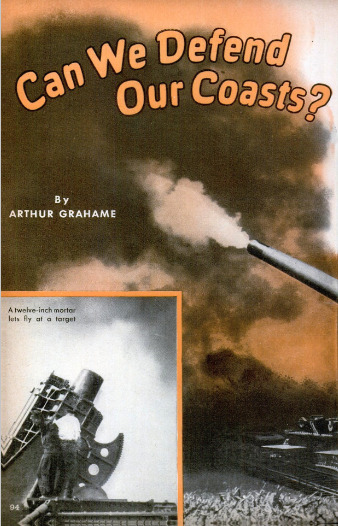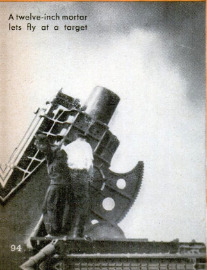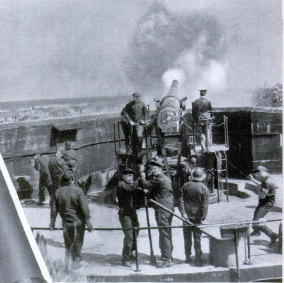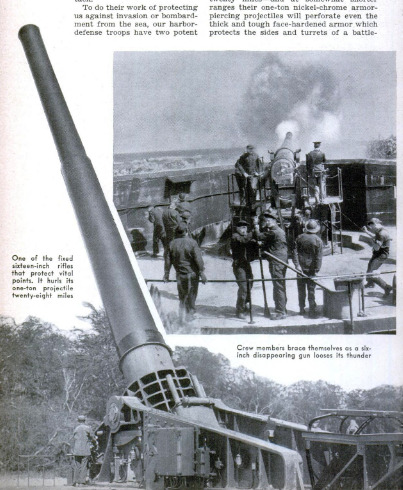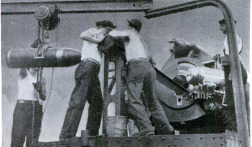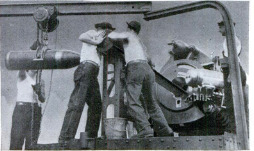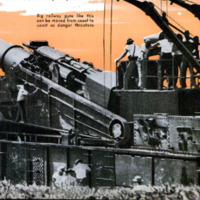-
Title (Dublin Core)
-
Coastal artillery
-
Article Title and/or Image Caption (Dublin Core)
-
Can we defend our coasts?
-
extracted text (Extract Text)
-
MOST people think of the Navy as our
first line of defense. In one way it is,
and in another way it isn't. Its ma-
Jor war job would take it on an offensive
mission—to head off and defeat an ap-
proaching enemy fleet, far from our home
shores. Stringing out the big-gunned ships
for close-in defense of our long ocean fron-
tier would make their offensive use impossi-
ble, would abandon the seas to the adver-
sary, and would surrender our overseas pos-
sessions and our maritime routes for obtain-
ing vital war supplies. Our widely scattered
warships would be push-overs for a concen-
trated hostile fleet. Therefore our “ships of
the line” must be kept together, regardless
even of the off chance that fleets in the At-
lantic and Pacific might attack us simultan-
eously.
So if the word defense is used in its nar-
rower, close-to-home sense, the U. S. Navy
isn't a defensive weapon at all. Our first line
of defense becomes the Army's Coast Ar-
tillery Corps. Its seldom-written-about sol-
diers man the big guns that defend the Pan-
ama Canal, the Navy's billion-dollar service
station in Hawali, and our principal harbors
and seaport cities located on the mainland.
There aren't, and there never will be, |
enough guns in America to cover all our
‘many thousands of miles of seacoast. For- |
tunately, that sort of defense isn't necessary.
To have any real chance of success, a mod-
ern invading army must control well
equipped ports of disembarkation. Soldiers
sometimes can be landed on an open beach,
but it is next door to impossible to land
tanks, large-caliber field guns, and all the
other heavy material which is essential to
present-day mechanized warfare without
adequate facilities. So the chief wartime re-
sponsibility of the Coast Artillery would be
the protection of the United States against
invasion by keeping our important seaports
safe against capture.
Other of its numerous duties would be
guarding our thickly populated coast cities
against bombardment by enemy warships,
protecting the Navy's bases, and defending
the fortified strong points in our system of
seacoast defense, which would allow our
mobile ground Army and Air Force to re-
‘main concentrated for quick action against
an invader who took the long chance of land-
ing on some unprotected beach. To both the
Navy and the Army the harbor-defense ar-
tillery is as invaluable as a good goalie is to
a hockey team, and for the same reason—
by playing Kitty-bar-the-gate it gives the
rest of the team freedom to at-
tack,
To do their work of protecting
us against invasion or bombard
ment from the sea, our harbor-
defense troops have two potent
weapons—big guns and submarine mines.
The king-pins of their armament are the
mighty sixteen-inch guns—as large seacoast
guns as there are in the world except for
a few elghteen-inchers which the British
have mounted in their Singapore defenses.
They have an extreme range of twenty-
eight miles—the range of a sixteen-inch gun
mounted in a battleship turret is about
twenty miles—and at somewhat shorter
ranges their one-ton nickel-chrome armor-
plercing projectiles will perforate even the
thick and tough face-hardened armor which
protects the sides and turrets of a battle-
ship, and burst in the ship's vitals with ef-
fects likely to be deadly. Operated by elec-
trical machinery, they can be fired for in-
definite periods at an astoundingly high
rate of speed. It is these mighty weapons
Which are most depended on to keep any
hostile fleet well out of range of the vitally
important locks of the Panama Canal, the
naval base at Pearl Harbor in Hawaii, and
cities such as New York and San Francisco.
Disappearing guns, in which the recoil
throws the gun back to loading position be-
hind a parapet and counterweights bring it
‘back into firing position, aren’t being built
these days because
thedesignoftheircar- |
riages makes it im-
possible to give them
sufficient elevation.
for long-range fire. |
But we have a good |
many of them in our
coast defenses, and
their 1,560-pound |
projectiles have what
it takes to sink a
battleship —if the
‘battleship obligingly
comes within their
range of ten miles.
Another of our coast-
defense weapons
whose game is the
capital ship is the
twelve-inch gun,
with a range of sev-
enteen miles. The
high-angle plunging
fire of the twelve-
inch mortars mount-
ed in many of our
coast defenses is dan-
gerous against the
deck armor of any ship which ventures with-
in their eight-mile range. Batteries of ten-
inch and six-inch guns, which have ranges of
about eight miles, are for use against cruis-
ers, destroyers, transports, and other non-
capital ships. A hit in a vital spot by a six-
inch gun will put a destroyer out of action.
Three-inch rapid-fire guns, which have a
range of six miles, are used to protect mine
fields.
All our fixed seacoast guns are mounted in
harbor defenses, but not all of them are pro-
tected by concrete parapets or bombproof
emplacements. Against the growing menace
of the bombing airplane, concealment is con-
sidered even more important than protection,
and some of our newest big guns are mount-
ed in the open and depend on clever camou-
flage for comparative safety. Antiaircraft
guns, both fixed and mobile, are provided for
the protection of the big guns and the men
Who fight them from attack from the air.
Railway artillery is equally valuable for
supporting fixed guns in the defense of forti-
fied positions and for use against an invader
attempting a landing at a place not pro-
tected by permanent coast defense but with-
in a reasonable distance of a railroad line.
Fourteen-inch railway guns have a range
of twenty-four miles; their job is to attack
an invader's battleships and big cruisers.
Eight-inch railway guns have a range of
thirteen miles, and are for use against light-
er warships and transports. Railway artil-
lery has the important advantage of what
the soldiers call “strategical mobility” —al-
though it can't be moved very fast, it can
‘be moved from one coast to the other.
Regiments of 155-millimeter tractor-
drawn guns—the same type of heavy gun
that is used by our Field Artillery—also are
part of our coast-defense system. They are
‘capable of fairly high road speeds, and they
do not require previous-
ly prepared positions.
Their range is about
ten miles.
Both railway and
tractor guns are high-
ly important weapons
in the defense systems
of the Panama Canal
and Hawai.
Much less spectacular
than the Coast Artil-
lery's big guns, but
every bit as important
for the defense of our
harbors, are its fields of
submarine mines. Mine
flelds are carefully
planned in peacetime,
the mines and
their anchors and control wires stored, and
the mines laid at the outbreak of war. Con-
tact mines are used to block off the parts of
harbor entrances which need not be used by
friendly ships. Controlled mines are used to
guard entrances which must be used by
friendly shipping and which are within
range of the harbor-defense guns and
searchlights which protect the fields against
sweeping. The electrical control apparatus
may be set so that a mine will explode the
instant that a ship comes in contact with
it, or so that the mine will signal that it
has been struck and then will explode after
any desired number of seconds—a method
which makes it fairly certain that the mine
will explode while it is in contact with
the bottom of the ship. Until its firing
switch is closed, a controlled mine is
harmless.
During’ the peaceful years that followed
the end of the World War the Coast Artil-
lery, like the rest of the Army, suffered
from the starvation diet imposed on it by
inadequate appropriations. Our coast-de-
fense system, which had been one of the
world's best, was allowed to go downhill. In
1936 increased appropriations made it pos-
sible for the Coast Artillery to start im-
proving our Panama Canal and Hawaiian
defenses. Our Pacific Coast harbor defenses
also were improved. But until about a year
ago our Atlantic and Pacific seacoast de-
fenses were in a decidedly unsatisfactory
condition. Since then steady progress has
been made in improving them. Some forti-
fications have been modernized, an undis-
closed number of new guns have been
mounted, and the defenses against attack
from the air have been tremendously in-
creased. But we haven't gone nearly far
enough. We need more guns, and we need
more highly trained coast artillerymen to
handle them. |
-
Contributor (Dublin Core)
-
Arthur Grahame (article writer)
-
Language (Dublin Core)
-
eng
-
Date Issued (Dublin Core)
-
1940-09
-
pages (Bibliographic Ontology)
-
94-97, 218
-
Rights (Dublin Core)
-
Public domain
-
Archived by (Dublin Core)
-
Sami Akbiyik
-
Marco Bortolami (editor)
 Popular Science Monthly, v. 137, n. 3, 1940
Popular Science Monthly, v. 137, n. 3, 1940

